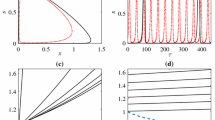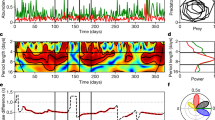Abstract
One of the more curious natural phenomena is the regular periodic variation in the populations of certain interacting species, a variation which does not correlate with known periodic external forces such as the cycles of darkness and light, the seasons, or weather cycles. Most commonly, these species are involved in a predator-prey relationship. The phenomenon has been observed in the microcosm of a laboratory culture (paramecium aurelia (predator) and saccharomyces exiguus (prey)—see D’Ancona [11]) and in the macrocosm of the Canadian coniferous forests (Canadian lynx (predator) and snowshoe hare (prey)—see Keith [17]). Other examples include the budworm-larch tree cycle in the Swiss Alps [2] and a lemming-vegetation cycle in Scandinavia [19]. We shall discuss only the lynx-hare cycle, but the mathematical models we shall develop are in principle applicable to any predator-prey interaction. In the course of our analysis we shall study the equilibria of coupled differential systems and the possible limit behavior of bounded orbits of such systems. This will all then be applied to the question of the existence of cycles in a predator-prey system.
Access this chapter
Tax calculation will be finalised at checkout
Purchases are for personal use only
Preview
Unable to display preview. Download preview PDF.
Similar content being viewed by others
References
F. Albrecht, H. Gatzke, A. Haddad and N. Wax, “The dynamics of two interacting populations,” J. Math. Anal.Applic., vol. 46, pp. 658–670, 1974. This is the definitive mathematical treatment of systems of the form of (15) under various pertinent hypotheses of f and g. Contains almost none of the biological or ecological interpretations. A brief bibliography is included.
W. Baltensweiler, “The cyclic population dynamics of the Grey Larch Tortix, Zeiraphera Griseana Hübner,” in Insect Abundance, edited by T.R.E. Southwood, Ed. Oxford: Blackwell, pp. 88–97.
W. E. Boyce and R. C. DiPrima, Elementary Differential Equations and Boundary Value Problems, 2nd ed. New York: Wiley, 1969. A very good book at the sophomore-junior level, with applications.
C. J. Brand, L. B. Keith and C. A. Fischer, “Lynx responses to changing snow-shoe hare densities in central Alberta,” J. Wildlife Management, 40 (3), vol. 40, no. 3, pp. 416–428, 1976. Continuation over the winters of 1971–1975 of field studies begun earlier [25]. Field data shows the complexities of the lynx-hare interaction.
M. Braun, Differential Equations and Their Applications, 2nd ed. New York: Springer-Verlag, 1978. This is one of the best books on the sophomore level; the presentation of the applications is especially good.
—, “Why the percentage of sharks caught in the Mediterranean Sea rose dramatically during World War I,” this volume, ch. 15. This is a slight alteration of [5, Section 4.9] and contains a good exposition of the Lotka-Volterra model.
M. G. Bulmer, “A statistical analysis of the 10-year cycle in Canada,” J.Anim. Ecol., vol. 43, pp. 701–718, 1971. A very interesting statistical analysis of the lynx-hare and several other 10-year cycles in the Canadian forests. Discusses 8-year cycles in the Siberian taiga. A very good bibliography.
—, “The theory of prey-predator oscillations,” Theoret. Pop. Bio., vol. 9, pp. 137–150, 1976. Further arguments that the hare cycle [cause unknown] drives the other cycles in the Canadian woods. Discussion of Kolmogorov’s Theorem.
E. A. Coddington and N. Levinson, Theory of Ordinary Differential Equations. New York: McGraw-Hill, 1955. Remains one of the standard graduate level texts.
C. S. Coleman, “Quadratic population models: Almost never any cycles,” this volume, ch. 16. Shows that if f and g in (15) are linear, then only “ecologically rare” cases such as the Lotka-Volterra system of Exercise 16 will contain any cycles at all.
U. D’Ancona, The Struggle for Existence Leiden, Brill, 1954. An interesting and readable account by the man who brought the strange increase in the numbers of selachia (sharks, skates, etc.) in the fishing areas of the Meditterranean to the attention of Volterra, who then formulated the first mathematical models of predator-prey species (see Exercise 16).
C. Elton and M. Nicholson, “The ten-year cycle in numbers of lynx in Canada,” J. Anim. Ecol., vol. 11 pp. 215–244, 1942. Contains the data from the records of the Hudson’s Bay Company. A good bibliography of the earlier sources.
J. C. Frauenthal, Introduction to Population Modeling. Birkhäuser, 1980. An outstanding treatment of population modeling. Treats stochastic and time-delay models as well as the deterministic and instantaneous. (In the UMAP Expository Monograph Series.)
G. F. Gause, The Struggle for Existence. Williams and Wilkins, 1934 (also Dover, 1971, paperback). A fascinating account of predator-préy and competing species relationships.
M. E. Gilpin, “Do hares eat lynx?,” Amer. Naturalist, vol. 107, pp. 727–730, 1973. Gilpin uses the actual data from Elton and Nicholson to find the best-fitting coefficients in his polynomial model and “proves” that the hare must be eating the lynx.
M. Hirsch and S. Smale, Differential Equations, Dynamical Systems, and Linear Algebra. New York: Academic, 1974. A very good treatment from a modern point of view, junior-senior level. Contains a good treatment of population models.
L. B. Keith, Wildlife’s Ten-Year Cycle. Madison: Univ. of Wisconsin, 1963. A thought-provoking account on a nonmathematical level of the various natural cycles in the vast Canadian forests. Should be read by anyone interested in natural cycles.
A. Kolmogorov, “Sulla Teoria di Volterra della Lotta per l’Esistenza,” G.Ist. Ital. Attuari, vol. 7, pp. 74–80, 1936. Certainly one of the more inaccessible sources. See May [23], Bulmer [8], or Albrecht et al. [1] for discussions of Kolmogorov’s Theorem.
D. L. Lack, The Natural Regulation of Animal Numbers. Oxford: Clarendon, 1954, pp. 212–217.
E. G. Leigh, “The ecological role of Volterra’s equations,” in Lectures on Mathematics in the Life Sciences, M. Gerstenhaber, Ed. Amer. Math. Soc., 1968, pp. 1–61. Gives a brief history of the equations and then presents Kerner’s statistical approach.
D. A. MacLulich, “Fluctuations in numbers of the varying hare (Lepus Americanus),” Univ of Toronto Studies, Biol. Ser., no. 43, pp. 1–136, 1937. A basic source for the snowshoe hare cycle.
R. M. May, Stability and Complexity in Model Ecosystems. Princeton, NJ: Princeton Univ. Press, 1973. A fascinating and readable account. Excellent bibliography.
—, “Limit cycles in predator-prey communities,” Science, vol. 177, pp. 900–902, 1972. A discussion of Kolmogorov’s theorem. A good bibliography.
J. Maynard Smith, Models in Ecology. Cambridge, 1974. Comparable to May [22]. Very good discussion of models. Good bibliography.
C. H. Nellis, S. P. Wetmore and L. B. Keith, “Lynx-prey interactions in central Alberta,” J.Wildlife Management, vol. 36, pp. 320–329, 1972. An analysis of the lynx population in a region in Alberta, Canada. The study was quite thorough and was carried out over the winters of 1964–1968. Peripheral studies of the local hare and grouse populations were also made. See also Brand et al. [4].
M. L. Rosenzweig, “Why the prey curve has a hump,” Amer. Natur., vol. 103, pp. 81–87, 1969. An indication that the prey isocline may rise before it falls; argument is based on the data from an actual predator-prey system.
J. Roughgarden, Theory of Population Genetics and Evolutionary Ecology: An Introduction. New York: Macmillan, 1979. A fascinating introduction to biological models. The first third of the book requires only a calculus background. The later chapters take the reader to the edge of current research. Limit cycles, Kolmogorov’s theorem, stochastic models, and much more are all discussed in informal terms.
M.S. Weinstein, “Hares, lynx, and trappers,” Amer. Naturalist, vol. 111, pp. 806–808, 1977. Weinstein claims that the cycles are not real but only reflect the trapping strategies of the hunters.
Author information
Authors and Affiliations
Editor information
Editors and Affiliations
Rights and permissions
Copyright information
© 1983 Springer-Verlag New York Inc.
About this chapter
Cite this chapter
Coleman, C.S. (1983). Biological Cycles and the Fivefold Way. In: Braun, M., Coleman, C.S., Drew, D.A. (eds) Differential Equation Models. Modules in Applied Mathematics. Springer, New York, NY. https://doi.org/10.1007/978-1-4612-5427-0_18
Download citation
DOI: https://doi.org/10.1007/978-1-4612-5427-0_18
Publisher Name: Springer, New York, NY
Print ISBN: 978-1-4612-5429-4
Online ISBN: 978-1-4612-5427-0
eBook Packages: Springer Book Archive




